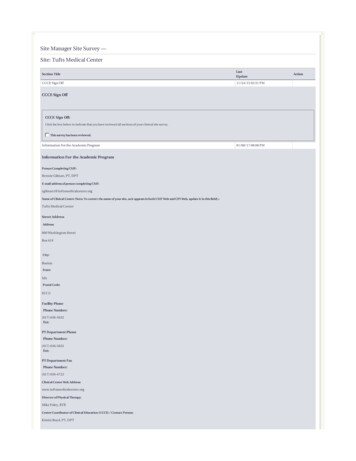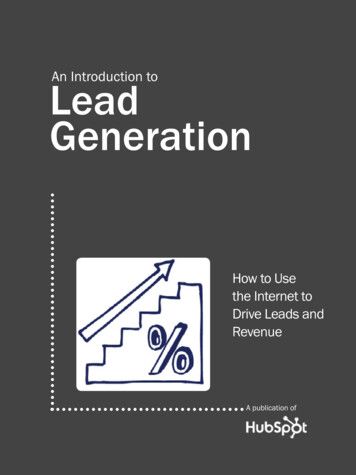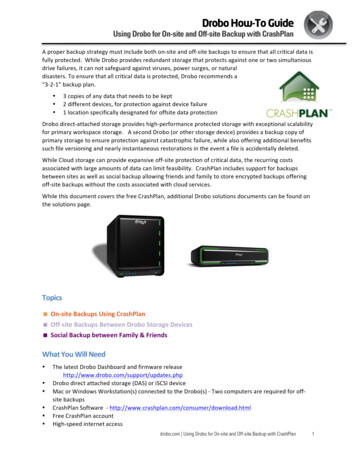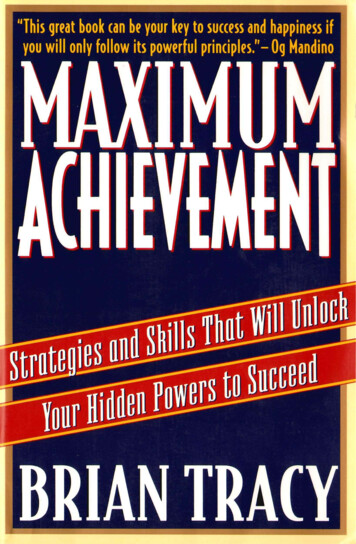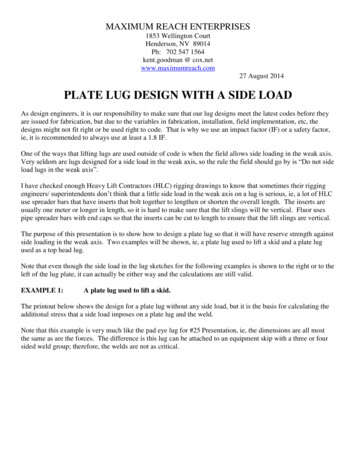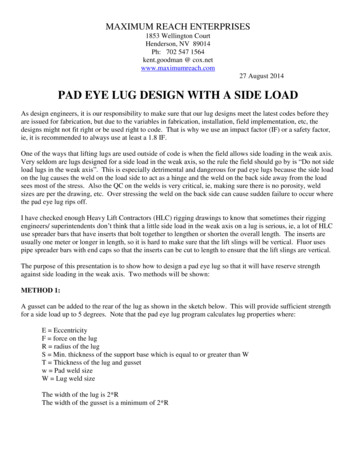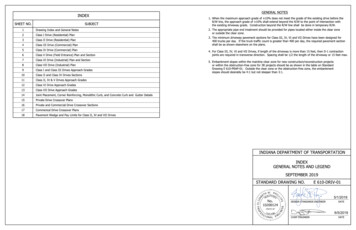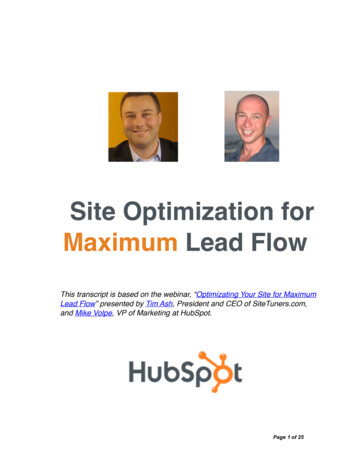
Transcription
! Site Optimization forMaximum Lead FlowThis transcript is based on the webinar, “Optimizating Your Site for MaximumLead Flow” presented by Tim Ash, President and CEO of SiteTuners.com,and Mike Volpe, VP of Marketing at HubSpot.Page 1 of 25
Mike Volpe:!I'm going to talk first for a little while and talk about how to sort ofoptimize your website to get more people to find your site. Then,Tim is going to share a lot of his expertise about landing pagesand how you get that conversion and all his expertise about that.And then, we'll have – we're definitely going to save a goodamount of time for questions at the end.!I think it's really important to set the stage for this and talk abouthow marketing is changing. I've got a couple stats here. Eighty-sixpercent of people skip television ads. 44 percent of direct mail isnever even looked at. It's discarded without even people reallyeven casting an eye upon it.!Those stats really get to the point that marketing is starting tochange and a lot of those older marketing tactics, those outboundmarketing tactics, are becoming less and less effective. I thinkthat that's a real problem today as marketers, and I think that a lotof us have an addiction, and I think we've got a really, really bigaddiction, and I think the addiction we have is to advertising.!The problem with advertising – there's some good benefits to it,but the problem with it to me is that every time you want to getmore people to find your website, every time you want to get moreexposure to folks, you have to pay more and more money for that.You're not really building up anything that's a long-term assetwithin your company. That addiction is built from a disease, andthe disease is Lazy Marketer Syndrome, because I really believethat if you're over-relying on advertising and it's the vast majorityof how you're attracting people to your business, that could be amistake. To some degree, it's being a little bit lazy.!I think the key reason why is that when you're advertising, you'rerenting the capability of building an audience and attractingpeople. You're renting that capability from someone else. And so,certainly, it could be a component of what you do, but I don't thinkit should be the only thing that you do, and I even would say itactually should be a minority of what you do.!And so that renting that capability, whether it's paying for GoogleAdwords or doing other things, I think if you want to have a longterm sustainable business, you should think about it from adifferent perspective. So, rather than renting that capability, Iwould argue that markets today should be building assets. ThePage 2 of 25
reason you should be building assets is that just like a factory andthe machinery in a factory, you have the capability of building upthose assets. If you have machinery, there's something that wouldactually be providing ongoing value to your company.!I think as a marketer you can build assets as well. If you build upa website that has a lot of links and some good SEO authority andyou're getting SEO traffic, I think that could be an asset. If youbuild up a blog that has a lot of folks that are subscribed to thatblog and visit and read that blog on a regular basis, to me, that'salso an asset. If you build up a big presence within social mediaand lots of people are following you and becoming fans andfriends, I think that's an asset as well. Building up an e-mail list isan asset, too.!And to me as a marketer those are the types of things that youshould think about doing. You should think about, "How am Ibuilding those assets to continue to add value to my company so Ican minimize the amount of cash that I'm spending each andevery month that isn't helping me build an asset?" Because thesecond that your credit card is over the limit, most of thoseadvertising services immediately cut of your traffic.!There's one thing to be careful about here—your competition isn'tnecessarily who you think. It's not necessarily the person whosells the exact some product that you sell. Your competition tosome degree is people that are trying to attract that sameaudience even if they sell something different. So, if you sellproducts to – I don't know – women, for instance, then in someways, even though Oprah probably doesn't sell anything that yousell, her media presence and her company and her televisionstation and things like that are competition for the attention of yourcustomers.!In some ways, you need to think about that as you build up yourmarketing and do more of this inbound marketing. That'ssomething to think about in terms of who your competition is andwhat you're really up against.!Now, taking that idea and marketing methodology and bringing allthe different pieces together, we talk about inbound marketing. It'sa combination of search engine marketing, content marketing,social media marketing, conversion, lead nurturing, supportingyour sales team, things like that all in one place.Page 3 of 25
!Let's talk about some more specific tips about what you canactually do, because I'm very much a kind of roll-up-your-sleeveskind of marketer, and I really believe in doing things – not justtalking about them. Now, these tips that I'm going to talk about arebased on a lot of our experience from all sorts of our ownexperience working with our 4,000 customers and also all thedata we have from over 3 million websites that have been gradedin Website Grader. If you haven't used Website Grader yet, youshould definitely put your website in there at websitegrader.com. Itgives you a free report. It's a really cool tool, and again, a lot ofthe things I'm going to talk about are sort of lessons gleaned fromlooking at that data and also the rest of our experience.Identifying Buyer Personas!I've got three tips here, and I know that this one is actually goingto be interesting, because I know that Tim has a different opinionon this, so you will get to hear both sides. But, I really feel like thatyour buyer persona is what should drive the content that you'recreating. Think about that example and don't forget that maybeOprah or maybe some other folks are actually your competition.It's not just the people who are selling the same products as you.It's people that are competing for those peoples' time andattention on the Web.!Really what you want to do is think about who your buyer personais. Now, at HubSpot, we've actually taken this almost to theextreme. We've created a couple buyer personas with a lot ofdetail there, and one of the personas that we sell to is MarketingMary. We've gone as far as building that up into our CRM systemwhen we track those different personas with our sales team.!What's important is not necessarily that you get the persona 100percent right, but if you can get it kind of 90 percent right. To me,having that ability, having that understanding of who that personis, will help you decide what content you should be producing,what content those people are more likely to share in socialmedia, what content they're more likely to subscribe to, whatthings they're probably searching. Having a deeper understandingof who that person can be really, really helpful.!Companies do this in all different ways. This is actually a photofrom a company called Cadence, a software company inMassachusetts. It looks like there are four people there, but thetwo middle figures are actually cardboard cutouts, and they'vePage 4 of 25
gone as far as embracing those personas as cardboard cutouts.That's an interesting way to go to really bring those personas tolife.!And I will tell you that all the content that we create here atHubSpot, we're constantly thinking about our sort of two mostimportant personas and asking ourselves, "Would this personalike this content?" We call them by name. We say things like,"Well, would Mary really like this webinar? Is that the thing Marywould be interested in? Why would Mary share that with herfriends?"!If you can have that mindset, you're going to start to think a littlebit more like a media company and having that capability, again,to maybe compete more with the media moguls like Oprah andhave a better shot of attracting your audience.!First, use data, but don't be a slave to it. Have some surveys,have some interviews and have some data of what your personais doing. But again, it's really more to gain an understanding ofwho this person is and what their personality is like and whattypes of things they're interested in than to nail exactly sort of thevery data driven things on this one.!I think it's really important to get personal and specific. Youshouldn't have just a general idea. It's more important to actuallyget specific and narrow, and have a firm understanding of whothese people are rather than just saying the high-level audienceof, "Oh, well, our customer is a woman between 45 and 60," orsomething like that. I would actually get really specific even if thatexcludes some portions of the audience.!The perfect is the enemy of the good. Don't over-engineer this toomuch. It's more important to have something that you can workwith and call by name to have those internal conversations aboutwhat would our persona like. From there, you can evolve andmake your personas more focused and viable, more specific andbetter over time.!We use our personas throughout the entire company here, and Ithink that's really important. So, it's not just about marketing. It'sabout sales. It's about product development. It's about customersupport. It's about finance. It is the thing that we rally around interms of how we understand our customers. We use them notonly for creating content in the marketing side of things, but alsoother things outside of that as well.Page 5 of 25
Publish, Donʼt Advertise!All right, my second tip is to publish, don't advertise. If you'readvertising on this site – for most display ads on the Web, you'regetting kind of a 0.2 percent or even lower than that click-throughrate – 0.1 percent click-through rate. Most people ignoreadvertisement, right? To me that says I don't want to be theadvertiser as much as I want to be the content. So, what I want tothink about is how do I build up that presence? What do I do?!Here at HubSpot we publish as much as we can. We've got a blogthat we publish to 40,000 subscribers and tons of readers. We doa podcast, so we actually stream this live every Friday at 4pmET– this is HubSpot TV. We put that into iTunes as well, and weget thousands of people who watch those archives episodesthere.!We do lots of videos. We've got a couple hundred videos onYouTube. We got hundreds of thousands of people that haveviewed those. We upload photos. We do presentations onSlideShare. We publish eBooks, news releases—all thesedifferent things, and the reason we do all of that is because wewant to have content in all these different forms of consumptionincluding this content we're creating right now, the webinar, inorder to give as many types of content to those personas that wethink that they would be interested in.!We've got data that sort of backs up this thesis that if you'republishing, you can attract a lot of people to your site and intoyour business as leads and sales at a low cost.!We've looked at over 1,500 small-medium sized business andcompanies that had a blog, on average, had 55 percent morewebsite traffic. Certainly, there are probably some other thingsthat go along with that, because companies that have a blog aremaybe a little bit more sophisticated, etc., but if you want to actlike those companies that are getting more traffic, one of the keythings you can do is start to blog. It gives you more pages.!Not only do you get more traffic if you start to blog and start tocreate content, but you also get more success in social media.The data that we looked at (from over 2,000 businesses) showsthat if you have a blog, you get 79 percent more followers onTwitter. Basically, if you're creating more content, it's making youmore interesting.Page 6 of 25
!Content is what makes you interesting in social media, so thethings that people like to share within social media, maybe acomedian or maybe someone like that, could be funny in a shortstatus update or interesting. To me, most businesses need a littlebit more than 140 characters, and that's why all these servicesallow you to have links in those status updates. And to me, that'sthe content that makes us interesting.!So, the reason HubSpot has more than 80,000 followers onTwitter is because of the content that we created. It's not becauseour tweets individually without those links are that interesting. Thefoundation of a good social media strategy is to be publishing andcreating some great content.Blogging Tips!So, let's talk about some of these tips for blogging. The first one isthat the title should be keyword rich. You want to use goodkeywords – keywords that your personas would be searching for– in your titles.!Most of the things I've seen show that having an image in everyarticle is good. It makes it more visually appealing. It gives peoplesomething to gravitate towards rather than just a whole bunch oftext on the page.!I would use both e-mail and RSS subscription. Certainly, mostblogging services include RSS. There are ways to do emailsubscription as well. When you publish a new blog article, it canautomatically go to the people subscribing to the blog by e-mail.For us, about a third of our blog subscribers are by e-mail. Otherfolks have 70 or 80 percent of their blog readers subscribe byemail. Some personas use RSS, some use email more, and youshould have both of those available to make sure that you'remaking it as easy as possible for people to get your blog content ifthey're interested in it.!The other thing that's really important is leveraging calls to actionin order to drive more traffic to your landing pages. It's importantto have a call to action in every article, and that's basically a linkto something where people can register, opt-in, start a trial, buy aproduct, something like that to get them moving down the salesand marketing process. I can tell you that by adding calls to actionPage 7 of 25
to our blog, we almost tripled the number of leads we were gettingfrom our blog.!People often ask me, “How do I get more comments?” Some ofthe great ways to do that: ask a question at the end of the articleor be controversial. The more controversial you are, the morecomments you will get. I know that from experience. Also, leavepart of the issue untouched. If you completely cover a topic,you're not really leaving room for people to add something to it.!If you need article ideas, check your sent items in your email.Most people, businesses and marketers are getting questions allday long from customers and potential customers about all sortsof things. Checking and seeing how you've answered thosequestions can be a great way to cover popular topics. You canalso look at FAQs from your sales people.!I also think it's important engage the whole company and notdump all the blogging and content-creation responsibility on oneperson. How do you engage the whole company? We've tried abunch of things here at HubSpot and have 80 different peoplewho have written for our blog. We do contests. We do publicpraise. We've certainly been able to garner a lot of support fromour executives. We've built it into some of the employee goals fora couple of different groups in the company. Get everyoneaddicted to the process of blogging, the feedback and the positiveloop that can happen by publishing an article.How to Make Search Engines Happy!It's important to make all search engines happy. Search enginestraditionally have looked at two fundamental things when theydecide who to show in the search results on that first page whenyour persona, goes to make a search. They look at the contextand the authority. The context is what's happening on each pageof your website, and the authority is how important your website ison the Internet.!You need to be careful about the keyword selection and thinkabout your personas—not what you want to be known as, butwhat your personas would call you. So, someone who does workon people who have been in a car accident and have damage totheir teeth is technically called a prosthodontist. The problem withPage 8 of 25
that is, most people would call that person probably somethingmore like a “cosmetic dentist.” If you compare the number ofpeople searching for each of those phrases, there's a lot morepeople searching for a cosmetic dentist. Even though the trueprofessional in the field would probably prefer to be known as aprosthodontist, the content that you would want to create andoptimize for would be for a cosmetic dentist.!Once you have done some keyword selection and figured outwhat keywords your personas are going to be looking for, youshould think about including those in the page title and in theURL as well as in the content and the description of the page.Those are the basic places that you could optimize to make eachpage show up a little bit higher in search results.!You should also think about making your site attractive to both thecrawlers and the humans. If a few pictures (and no text) on a sitetell the story of a resort in Vermont, Google actually doesn't knowwhat the site is about. The pictures convey the story to me. ButGoogle can't see those. Basically, you need to have some textthat is describing your business so that the search engines couldunderstand it.!What's interesting, though, is that authority is actually moreimportant than your On-page SEO. So, authority is probably 70 to80 percent of the reason why any page ranks for any givenkeyword phrase. Fundamentally, you need more links coming intoyour website. So if you have a blog, you tend to be producingmore interesting content, and you get more links.What's interesting is that you don't actually need a lot of links.Your homepage should have tons and tons of links. Pagesbesides your homepage, if they just have seven links incoming tothose pages from other websites, that actually puts them better offthan 85 percent of the pages on the Internet. Most pages on theInternet have very, very few links. Getting just seven to ten linksinto a given page can make a huge, huge difference.!Prepare for the Future of Search!Where is search going? Today search engines are starting toincorporate additional signals to figure out that authority. Socialmedia has become really important and the “like” is starting toreplace or become as important as the link. As people like yourcontent or tweet your content, that is adding authority to yourPage 9 of 25
website. What you want to be doing today is leveraging thatphenomenon in order to build more and more authority.!Some of the things you should be doing for SEO include usingkeywords in the language that your buyer persona uses. Focus ongreat content more than technical tweaks, because that greatcontent is what's going to attract a lot of links and a lot of “likes.”Train the people creating content within your business on SEO.!My advice for the road ahead would be stop thinking like amarketer or stop thinking especially like an advertiser; think a lotmore like a publisher and a socializer. That's what's going to startto attract a lot of people to your website, help you turn marketingfrom into an asset.Tim Ash:!My perspective is basically looking at the world and finding thatit's messed up.!Back in the early ʼ80s, when I was at UC San Diego, it was ahotbed for usability research. In fact, I studied under Don Normawho's arguably one of the top people in the field. He was the guythat literally wrote the book on user-centered design. So, a lot ofthe things that you have to say, and the paying attention to thecustomers and to your visitors, that really resonates with me.!We've been working with lots of companies both in a consultingbest practices capacity and also doing live website or landingpage tests to see what actually wor
in Website Grader. If you haven't used Website Grader yet, you should definitely put your website in there at websitegrader.com. It gives you a free report. It's a really cool tool, and again, a lot of the things I
